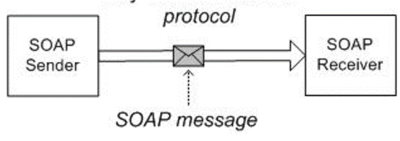Simple Object Access Protocol (SOAP)
SOAP (Simple Object Access Protocol) is the foundational, XML-based application protocol used to implement Web services within a SOA (Service Oriented Architecture). SOAP is transported primarily via HTTP and middleware messaging systems (JMS, MQ Series, MSMQ, Tuxedo, TIBCO RV) but can also be transported via other protocols such as SMTP (Simple Mail Transfer Protocol) and FTP (File Transfer Protocol).[1]
The official definition, found in the most recent SOAP 1.2 specification, "SOAP is a lightweight protocol intended for exchanging structured information in a decentralized, distributed environment. SOAP uses XML technologies to define an extensible messaging framework, which provides a message construct that can be exchanged over a variety of underlying protocols. The framework has been designed to be independent of any particular programming model and other implementation specific semantics." This definition really gets to the heart of what SOAP. SOAP defines a way to move XML messages from point A to point B (see Figure below). It does this by providing an XML-based messaging framework that is
1) extensible,
2) usable over a variety of underlying networking protocols, and
3) independent of programming models.[2]

source: [2]
SOAP Vs. REST[3]
Both REST and SOAP offer a means of communications between web-service. REST is merely a convention implemented using the HTTP protocol and is therefore considered simpler to learn and implement.
SOAP provides the following advantages when compared to REST:
- Language, platform, and transport independent (REST requires the use of HTTP)
- compatible with distributed enterprise environments ( direct point-to-point communication)
- All calls sent through POST
- Provides significant pre-build extensibility in the form of the WS* standards
- Built-in error handling
- Automation when used with certain language products
REST is easier to use and is more flexible. It has the following advantages compared to SOAP:
- Uses easy to understand standards like swagger and OpenAPI – Specification 3.0
- Easy to learn
- Efficient (SOAP uses XML for all messages, REST mostly uses smaller message formats like JSON) but also support XML format.
- Fast (no extensive processing required)
- Closer to other Web technologies in design philosophy
- Can be stateless or stateful
See Also
Enterprise Service Bus (ESB)
Service Oriented Architecture (SOA)
Enterprise Integration
Enterprise Architecture
